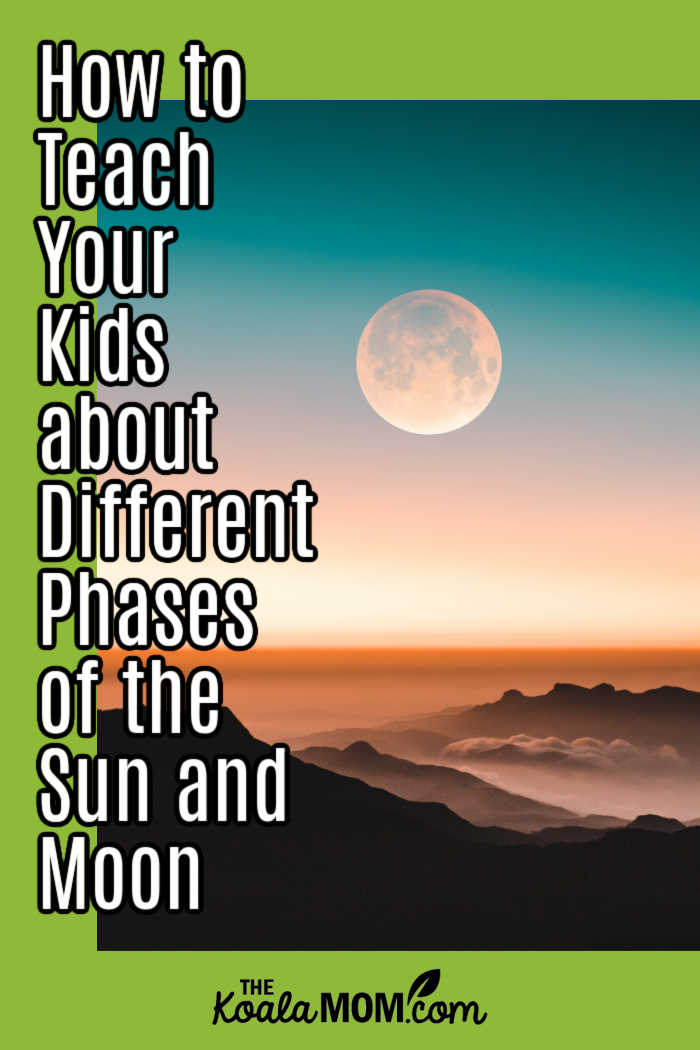Understanding the different phases of the Sun and Moon is not only intriguing but also an excellent opportunity to introduce your kids to the wonders of astronomy. By explaining the cycles and appearances of these celestial bodies, you can nurture their curiosity about the universe and help them develop a deeper appreciation for the natural world. In this article, we will explore effective methods to teach your kids about the various phases of the Sun and Moon, allowing them to grasp these concepts engagingly and memorably.

Exploring the Phases of the Moon
The moon, Earth’s only natural satellite, undergoes a regular sequence of phases as it orbits around our planet. This celestial dance creates captivating lunar cycles that can be observed and understood by children of all ages. Most kids notice on their own that the moon changes and ask the common question, “Why?”
To introduce your kids to the phases of the moon, start by explaining the concept of a lunar month, which spans approximately 29.5 days. Begin by demonstrating the new moon phase, where the moon is not visible from Earth. Then, help your children understand that as the moon moves in its orbit, its illumination gradually increases, revealing different phases such as crescent moon, first quarter, gibbous moon, and finally, the full moon.
Encourage your children to observe the moon regularly and maintain a journal of its changing appearance, fostering their observation skills and understanding of lunar patterns.
Discovering the Phases of the Sun
Teaching your kids about the phases of the sun provides an opportunity to explore our nearest star and its influence on Earth. While the sun doesn’t undergo phases like the Moon, it does exhibit a phenomenon known as sunspots, which are temporary dark spots on its surface. However, the primary focus here will be on discussing solar eclipses and how to safely view them.
A solar eclipse occurs when the moon passes between the sun and earth, blocking the sun’s light either partially or completely. Educate your children about the different types of solar eclipses, including partial, annular, and total eclipses. Emphasize the importance of wearing proper eye protection, such as eclipse glasses, to view a solar eclipse safely. Inform your kids that observing a solar eclipse directly with the naked eye can be harmful and should be avoided.
When and Where to View a Solar Eclipse
Experiencing a solar eclipse can be an awe-inspiring event for both children and adults alike. Knowing where and when to view a solar eclipse is crucial to ensuring a memorable and safe experience. To witness this celestial spectacle, inform your children that it’s important to keep track of astronomical events and consult reliable sources for accurate information.
Websites dedicated to astronomy or reputable space agencies often provide detailed eclipse predictions and maps, indicating the regions from where the eclipse will be visible. Encourage your kids to plan, research the upcoming eclipses, and identify suitable locations for observation, considering factors such as weather conditions and accessibility.
Unveiling the Lunar Eclipse
In addition to solar eclipses, lunar eclipses provide an excellent opportunity to teach your kids about the alignment of the sun, earth, and moon. A lunar eclipse occurs when the Earth casts its shadow on the Moon, resulting in dimming or reddening of the lunar surface.
To introduce the concept of lunar eclipses, explain to your children that they occur during a full moon phase.
Encourage them to observe the moon during a lunar eclipse and note the changes in its appearance. Explain that the reddish hue seen during a total lunar eclipse is due to sunlight filtering through earth’s atmosphere and bending around the planet, casting a warm glow on the moon. Engage your kids in discussions about the significance of lunar eclipses in various cultures and the scientific understanding behind this captivating phenomenon.
Understanding the Phases of the Sunspot Cycle
The Sunspot Cycle is a fascinating phenomenon that showcases the Sun’s varying activity levels. Sunspots are dark areas that appear on the Sun’s surface and are caused by strong magnetic activity. Teaching your kids about the sunspot cycle can help them understand the ever-changing nature of our star.
Start by explaining that the sun follows an approximately 11-year cycle during which the number and intensity of sunspots fluctuate. Show them images of sunspots and describe their characteristics. Encourage your children to create a timeline or a visual representation of the sunspot cycle, marking the periods of high and low activity. Discuss how scientists study sunspots and their impact on space weather, fostering their interest in both astronomy and the importance of monitoring the Sun’s behavior.
Engaging in Solar Observations
Safely observing the Sun can provide valuable insights into its behavior and teach your kids about the importance of protecting their eyes. Engaging in solar observations allows children to witness the dynamic nature of our closest star and witness phenomena like sunspots and solar flares.
Educate your children about the proper equipment for solar observations, such as solar filters or telescopes with solar filters. Explain the dangers of looking directly at the Sun without protection. Together, set up a solar observation station using the appropriate equipment and guide them through the process of aligning the telescope or filtering the sunlight.
Encourage them to sketch or photograph their observations and discuss their findings. By engaging in solar observations, your kids can develop a deeper appreciation for the Sun’s activity and its impact on our planet.

In conclusion, teaching your kids about the different phases of the Sun and Moon is an exciting opportunity to spark their curiosity and deepen their understanding of the universe. By exploring lunar phases, solar and lunar eclipses, the Sunspot Cycle, and engaging in safe solar observations, you can inspire a lifelong fascination with astronomy. Encourage hands-on activities, and regular observations, and prioritize safety during solar events. Together, you can embark on a journey of exploration and discovery, nurturing a love for the wonders of the cosmos in your children.

No Responses Yet